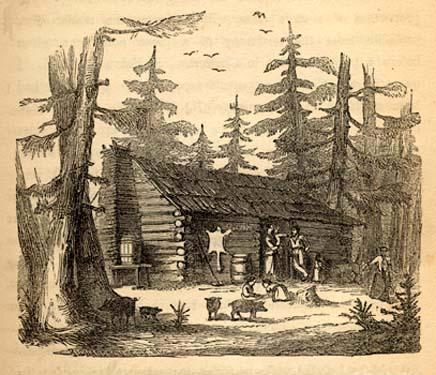A Log House in the Woods of Antebellum North Carolina
Two people stand talking in front of a log cabin surrounded by pine trees. Pigs roam freely in the yard where two children are playing. A pelt hangs on the wall of the cabin. Another person, possibly a slave, is working in the woods nearby. Illustration by Fredrick Law Olmsted (1822-1903). From his book, A Journey in the Seaboard Slave States; With Remarks on Their Economy.
Olmstead was a famous landscape architect and antebellum traveler. Olmstead traveled South in 1852. In his book Olmstead discusses the low quality and number of roads and travel accommodations in the area. In general he is happy with Raleigh and its architecture and evergreens. Olmstead also talks about the turpentine and rosin production, naval stores, tobacco and tar industries. Olmstead was also concerned with the lack of urbanization, manufacutring, and agriculutural diversity in the South. He also concluded that slavery was damaging towards Southern economy and social growth.
Michael Sistrom. "Frendrick Law Olmsted, 1822-1903): A Journey in the Seaboard Slave States; With Remarks on Their Economy. Documenting the American South. University of North Carolina Chapel Hill. https://docsouth.unc.edu/nc/olmsted/summary.html . Accessed November 1 2018.

Olmstead, Fredrick Law. [A Log House in the Woods of North Carolina]. Illustration. UNC Chapel Hill: Documenting the American South. https://docsouth.unc.edu/nc/olmsted/ill5.html (Accessed November 1, 2018)
All Rights Reserved
"All rights reserved" is a traditional copyright term that indicates that the copyright holder reserves for his/her/their own use all of the rights given to copyright owners under U.S. copyright law. Items that are included in NCpedia and/or ANCHOR with this rights statement appear by agreement or permission from the rights holder or the institution that holds the item. Click "Available at" to visit the website for the collection where the item appears for more information about the rights or specific uses allowed. For all other non-specified uses, please contact the copyright holder or item owner.
Add a comment
PLEASE NOTE: NCpedia provides the comments feature as a way for viewers to engage with the resources. Comments are not published until reviewed by NCpedia editors at the State Library of NC, and the editors reserve the right to not publish any comment submitted that is considered inappropriate for this resource. NCpedia will not publish personal contact information in comments, questions, or responses. If you would like a reply by email, note that some email servers, such as public school accounts, are blocked from accepting messages from outside email servers or domains. If you prefer not to leave an email address, check back at your NCpedia comment for a reply. Please allow one business day for replies from NCpedia. Complete guidelines are available at https://ncpedia.org/about.